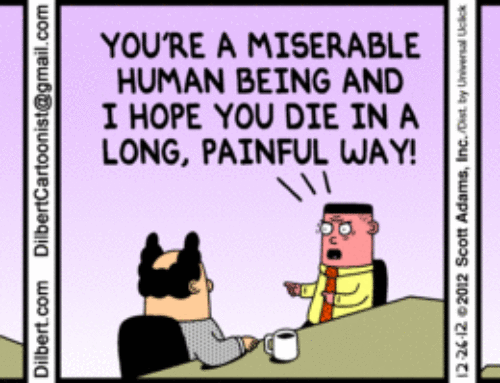Delivering difficult messages does not always come easy to some people, in fact it can be a real art to say what you think and get your point across without been seen as whinging or being overtly aggressive in your stance. Getting tough and saying what you need to say is an essential leadership skill, it helps others understand our expectations, gives us as chance to correct poor performance, and avoids situations where others may exploit our kind nature.
Why do we find it hard?
Here are some common reasons why giving difficult messages can be tough.
- we don’t like confrontation
- we’re worried about how the other person may react (aggressively or emotionally)
- we’re worried that they may criticise us
- we worry that we are seen as being overtly critical
- we worry that we may make a fool of ourselves
- we don’t feel we have the skills to do it
- people won’t like us if we get tough with them
Is it a skill or an attitude?
Handling difficult conversations is about 20% skill and 80% our own attitude. It is something we do, a behaviour, the way we act then gives the other person the impression we are being serious, but professional. Think of it as a cycle. The way we behave to others, then creates an impression in the other persons mind, they then react to that impression and so the cycle continues, so the trick is to create the right impression through what we say and what we do.
It’s a journey
The process for giving difficult messages is a journey, the actual part where we criticise the other person is only a small part of the total conversation, we spend more time planning what we need to say and then how to make sure the situation does not arise again.
1. Gather evidence
Before we say anything we need to get the hard facts – what was said to who, when, what actually happened, what documents might be needed, when did it take place, how long has it been going on for etc etc etc. Once you know the facts you can then form an opinion as to how serious the issue is and how you may need to handle it (i.e is it a disciplinary matter, or will a quiet word do)
2. Define outcomes
So we know the facts, next we need to work out what we want at the end of the meeting – we need to precisely define what we need from the other person to prevent this kind of thing happening again. If we can’t set clear objectives then there is a risk that the employee could leave the meeting confused and unclear of what they need to do going forward. Actions should be
- well defined
- easy to understand
- do able
- simple to review if they have been done
A poor objective would look like – ‘getting a better attitude’, ‘working harder and putting more effort in’ and so on, a good one would be ‘to meet the sales target of 20% by the end of the month’, or ‘complete all customer reports within 7 days of being received’ etc.
3. No surprises
Before having a tough conversation, always give the employee notice of a potential meeting, if you catch people on the fly they are likely to be very reactive and defensive to any criticism. Let the employee know you want to see them and give them time to think about the meeting before coming in. The amount of notice is dependant on the seriousness of the matter to be discussed, if its a simple thing then 5 – 10 mins should do it, if it could lead to disciplinary action, then 24 hours may be needed.
4. State, listen, question, solve
So you’re in the meeting, get to the point quickly and state the issue – focus on the facts of what happened and avoid making personal accusations – by focusing on the facts and presenting evidence the intention is to focus the mind of the employee on the specific events of what happened.
Once the issue has been said, rather than jumping straight to the solution, take time to question the employee to understand what happened, the circumstances of the event, contributing factors and the employees perspective of what went on. A good questioning technique to follow is where you start with a couple of open questions (can you tell, explain, describe….), then follow these up with probing questions (who,what, where, when….), when you have the answers, paraphrase what has been said and then ask a closed question to confirm that what has been said is correct.
Once you have concluded the questioning phase, you should then state your own opinion which has now been informed by the employees perspective.
The final step is to then discuss with the employee solutions to the problem. Keep an open mind and focus on getting an agreement to action from the employee rather than just telling them what they have to do.
5. Follow it up
Once you have had a difficult conversation and the employee has been working towards the goals always hold follow up meetings to show to the employee you were serious about the issue and you can either offer praise as things have got better, or hold a further discussion as performance has not improved sufficiently.
If you fail to follow it up the employee may feel that the matter was not that serious or rely on you forgetting to check on them any further, and so may not actually do what you have agreed.
We specialise in writing and delivering very practical training sessions for organisations and leaders on how to hold difficult conversations – for more information please get in touch.





